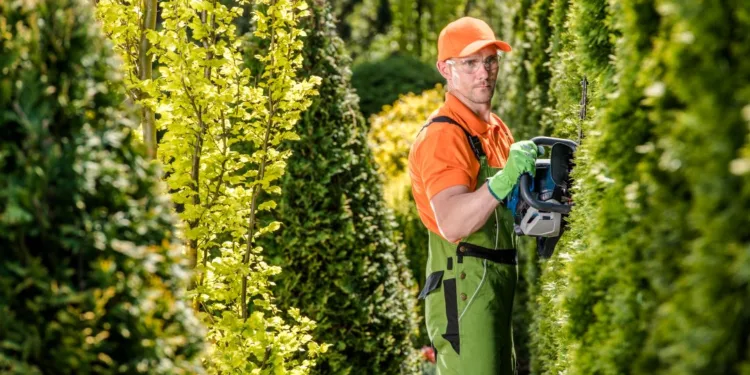Hedge trimming is an essential gardening task that helps maintain the health, appearance, and shape of hedges, shrubs, and bushes. Properly trimmed hedges can enhance the aesthetic appeal of a garden, provide privacy, and create a well-manicured landscape. This ultimate guide will cover the tools, techniques, and timing needed to master the art of hedge trimming.
Tools for Hedge Trimming
Choosing the right tools is crucial for efficient and effective hedge trimming. Here are the essential tools you’ll need:
1. Hedge Trimmers
Hedge trimmers are the primary tool for cutting and shaping hedges. There are three main types of hedge trimmers:
- Electric Hedge Trimmers: These are powered by electricity and come in corded and cordless (battery-powered) models. Electric trimmers are lightweight, easy to use, and suitable for small to medium-sized hedges.
- Gas Hedge Trimmers: These are powered by gasoline and are known for their power and performance. Gas trimmers are ideal for large hedges and heavy-duty trimming tasks but require regular maintenance.
- Manual Hedge Trimmers: Also known as hedge shears, these are hand-operated tools that provide precise control for detailed trimming. They are best suited for small hedges and shaping tasks.
2. Pruning Shears
Pruning shears, or secateurs, are essential for cutting individual branches and stems that are too thick for hedge trimmers. They come in two types: bypass and anvil. Bypass pruners are ideal for live, green wood, while anvil pruners are better for dead or dry wood.
3. Loppers
Loppers are long-handled pruning tools designed for cutting thicker branches that are out of reach for pruning shears. They provide additional leverage and are suitable for branches up to 2 inches in diameter.
4. Pole Pruners
Pole pruners are extendable tools that allow you to reach high branches without using a ladder. They are ideal for tall hedges and trees and come in manual, electric, and gas-powered models.
5. Protective Gear
Safety is essential when trimming hedges. Wear protective gear, including:
- Gloves: To protect your hands from thorns, sharp branches, and blisters.
- Safety Glasses: To shield your eyes from debris and branches.
- Ear Protection: Especially important when using loud gas-powered trimmers.
- Long Sleeves and Pants: To protect your skin from scratches and cuts.
Techniques for Hedge Trimming
Mastering the right techniques is essential for achieving a well-manicured hedge. Here are some key techniques to follow:
1. Preparing the Hedge
Before you start trimming, inspect the hedge for any dead or diseased branches and remove them using pruning shears or loppers. This will promote healthy growth and prevent the spread of disease.
2. Shaping the Hedge
Decide on the desired shape and height of the hedge before you start trimming. Common hedge shapes include:
- Formal Hedges: These are neatly trimmed and have a uniform shape, such as rectangular or rounded.
- Informal Hedges: These have a more natural and irregular shape, requiring less frequent trimming.
3. Trimming Technique
- Bottom to Top: Start trimming from the bottom of the hedge and work your way up. This ensures that the lower branches receive adequate sunlight and promotes even growth.
- Angle the Trimmer: Hold the trimmer at a slight angle to create a tapered shape, with the base of the hedge wider than the top. This allows sunlight to reach all parts of the hedge and prevents the top from becoming too dense.
- Cut in Small Sections: Trim small sections at a time to maintain control and precision. Avoid cutting too much at once, as this can damage the hedge and create an uneven appearance.
4. Pruning Technique
- Selective Pruning: Use pruning shears or loppers to selectively remove individual branches and stems. This technique is ideal for shaping and thinning the hedge without causing excessive stress to the plant.
- Thinning: Thinning involves removing some of the inner branches to improve air circulation and light penetration. This promotes healthy growth and reduces the risk of disease.
5. Clean-Up
After trimming, collect and dispose of the cut branches and leaves. This prevents pests and diseases from thriving in the debris and keeps your garden tidy.
Timing for Hedge Trimming
The timing of hedge trimming is crucial for promoting healthy growth and achieving the best results. Different types of hedges have specific trimming schedules:
1. Evergreen Hedges
Evergreen hedges, such as boxwood, yew, and holly, retain their foliage year-round. They require regular trimming to maintain their shape and density.
- Spring Trimming: Trim evergreen hedges in late spring, after the new growth has emerged. This encourages healthy growth and helps maintain the desired shape.
- Summer Trimming: Perform a light trim in mid-summer to maintain the shape and remove any excessive growth.
- Avoid Late Fall Trimming: Avoid trimming evergreen hedges in late fall, as this can expose the plants to winter damage.
2. Deciduous Hedges
Deciduous hedges, such as beech, hornbeam, and privet, lose their leaves in the fall. They require trimming at specific times to promote healthy growth.
- Winter Trimming: Trim deciduous hedges in late winter or early spring before new growth begins. This helps promote healthy growth and ensures the hedge retains its shape.
- Summer Trimming: Perform a light trim in mid-summer to maintain the shape and remove any excessive growth.
- Avoid Late Summer Trimming: Avoid trimming deciduous hedges in late summer, as this can stimulate new growth that may not harden off before winter.
3. Flowering Hedges
Flowering hedges, such as lilac, forsythia, and spirea, require careful timing to ensure they bloom properly.
- Spring-Flowering Hedges: Trim spring-flowering hedges immediately after they finish blooming. This allows the plants to develop new growth and flower buds for the next season.
- Summer-Flowering Hedges: Trim summer-flowering hedges in late winter or early spring before new growth begins. This promotes healthy growth and ensures abundant blooms.
Common Hedge Trimming Mistakes to Avoid
Avoiding common mistakes can help you achieve a well-manicured and healthy hedge. Here are some mistakes to watch out for:
1. Trimming at the Wrong Time
Trimming at the wrong time can stress the plants and affect their growth. Follow the recommended trimming schedules for different types of hedges to ensure optimal health and appearance.
2. Over-Trimming
Over-trimming can weaken the hedge and make it more susceptible to disease and pests. Trim small sections at a time and avoid cutting too much at once.
3. Uneven Trimming
Uneven trimming can create an unattractive and unbalanced appearance. Use a level or string line to guide your cuts and ensure a uniform shape.
4. Neglecting Maintenance
Neglecting regular trimming and maintenance can result in overgrown and unhealthy hedges. Perform regular trimming and pruning to promote healthy growth and maintain the desired shape.
Tips for Achieving the Best Results
Here are some additional tips to help you achieve the best results when trimming hedges:
1. Use Sharp Tools
Sharp tools provide clean cuts and reduce the risk of damaging the plants. Regularly sharpen your hedge trimmers, pruning shears, and loppers to ensure efficient and effective trimming.
2. Water and Fertilize
Water and fertilize your hedges regularly to promote healthy growth. Well-nourished plants are more resilient to stress and produce better results after trimming.
3. Monitor for Pests and Diseases
Regularly inspect your hedges for signs of pests and diseases. Early detection and treatment can prevent serious damage and ensure the health of your plants.
4. Mulch the Base
Mulch the base of your hedges to retain moisture, suppress weeds, and improve soil health. Use organic mulch, such as wood chips or compost, to provide additional nutrients to the plants.
Conclusion
Hedge trimming is an essential gardening task that requires the right tools, techniques, and timing to achieve the best results. By choosing the appropriate tools, mastering the proper techniques, and following the recommended trimming schedules, you can maintain healthy, well-shaped hedges that enhance the beauty of your garden.
Remember to prioritize safety, use sharp tools, and monitor your hedges for pests and diseases. With the knowledge and tips provided in this ultimate guide, you’ll be well-equipped to tackle any hedge trimming task and create a stunning landscape.



























